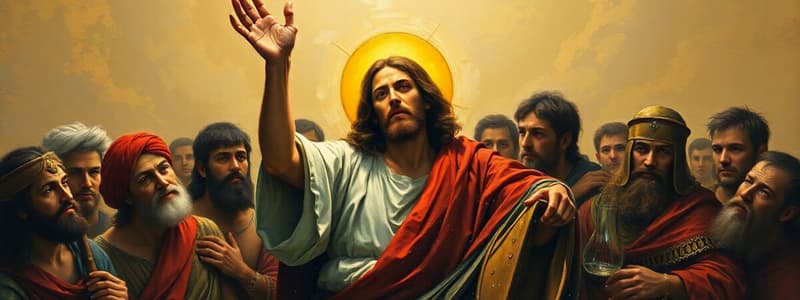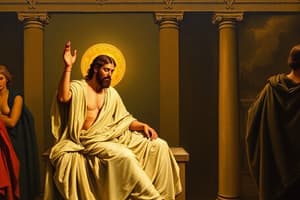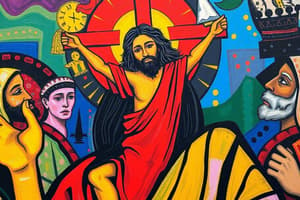Podcast
Questions and Answers
Which factor contributed most to the initial spread of Christianity beyond its Jewish origins?
Which factor contributed most to the initial spread of Christianity beyond its Jewish origins?
- The establishment of a universal banking system.
- The construction of new temples allowed for wider worship.
- The development of advanced agricultural techniques.
- Jewish persecution of Christians dispersing believers and the conversion of Paul. (correct)
What was the primary accusation leveled against Christians by the Romans, leading to their persecution?
What was the primary accusation leveled against Christians by the Romans, leading to their persecution?
- Their refusal to acknowledge Caesar as Lord by burning incense on altars. (correct)
- Their strict adherence to dietary laws.
- Their practice of holding secret religious ceremonies.
- Their refusal to engage in commerce and trade.
The destruction of Jerusalem in AD 70 by Roman forces was interpreted by Christians as divine judgment on the Jewish people for rejecting Jesus as the Messiah.
The destruction of Jerusalem in AD 70 by Roman forces was interpreted by Christians as divine judgment on the Jewish people for rejecting Jesus as the Messiah.
True (A)
What key event led to a significant shift in the Roman Empire's attitude towards Christianity in 313 AD?
What key event led to a significant shift in the Roman Empire's attitude towards Christianity in 313 AD?
Why did the Romans consider Christians to be 'haters of humanity'?
Why did the Romans consider Christians to be 'haters of humanity'?
The translation of the Hebrew Old Testament into Greek, enabling both Hellenistic Jews and Gentiles to understand it, is known as the ______.
The translation of the Hebrew Old Testament into Greek, enabling both Hellenistic Jews and Gentiles to understand it, is known as the ______.
What was the significance of the Council of Nicaea called by Constantine in 325 AD?
What was the significance of the Council of Nicaea called by Constantine in 325 AD?
Monasticism, which became popular in the church following its acceptance in Roman society, perfectly aligned with the New Testament teachings on how Christians should engage with the world.
Monasticism, which became popular in the church following its acceptance in Roman society, perfectly aligned with the New Testament teachings on how Christians should engage with the world.
Which apostle is most known for writing a majority of the New Testament epistles and spreading the gospel to the Gentiles throughout the Roman world?
Which apostle is most known for writing a majority of the New Testament epistles and spreading the gospel to the Gentiles throughout the Roman world?
What event solidified Christianity as the official religion of the Roman state, and under whose rule did this occur?
What event solidified Christianity as the official religion of the Roman state, and under whose rule did this occur?
What was the key factor that facilitated the easy exchange of ideas during the time of Christ, aiding in the spread of Christianity?
What was the key factor that facilitated the easy exchange of ideas during the time of Christ, aiding in the spread of Christianity?
Despite facing immense persecution from the Roman Empire, the number of Christians decreased significantly, leading to the eventual decline of the church.
Despite facing immense persecution from the Roman Empire, the number of Christians decreased significantly, leading to the eventual decline of the church.
What was the primary role of synagogues established by 'scattered' Jews after the destruction of Jerusalem in 586 BC?
What was the primary role of synagogues established by 'scattered' Jews after the destruction of Jerusalem in 586 BC?
What did the Roman emperor Constantine claim to have seen before a crucial battle, which led to his public embrace of Christianity?
What did the Roman emperor Constantine claim to have seen before a crucial battle, which led to his public embrace of Christianity?
What was the primary reason the Jewish religious leaders sought to have Jesus killed?
What was the primary reason the Jewish religious leaders sought to have Jesus killed?
The early Christian leader from Smyrna, who refused to renounce his faith and was burned at the stake, was named ______.
The early Christian leader from Smyrna, who refused to renounce his faith and was burned at the stake, was named ______.
What administrative structure did the church adopt by the fourth century, mirroring the organization of the Roman Empire?
What administrative structure did the church adopt by the fourth century, mirroring the organization of the Roman Empire?
The apostle Paul was born a Roman citizen and persecuted Christians before converting to Christianity.
The apostle Paul was born a Roman citizen and persecuted Christians before converting to Christianity.
According to the passage, what did Jesus declare about entering the kingdom of God?
According to the passage, what did Jesus declare about entering the kingdom of God?
Match the following figures or concepts with their descriptions:
Match the following figures or concepts with their descriptions:
What did the Romans expect would happen as a result of their persecution of Christians?
What did the Romans expect would happen as a result of their persecution of Christians?
What specific charge did Jewish religious leaders bring against Jesus before Pontius Pilate to persuade him to order Jesus’s execution?
What specific charge did Jewish religious leaders bring against Jesus before Pontius Pilate to persuade him to order Jesus’s execution?
The early church maintained a strict separation between its members and the secular world, with Christians avoiding all forms of interaction with non-believers.
The early church maintained a strict separation between its members and the secular world, with Christians avoiding all forms of interaction with non-believers.
How did the early Christians typically organize their communal life and worship?
How did the early Christians typically organize their communal life and worship?
What was the theological significance of the Resurrection of Jesus Christ for early Christians?
What was the theological significance of the Resurrection of Jesus Christ for early Christians?
Flashcards
World Made Ready
World Made Ready
God orchestrated events and civilizations to prepare the world for Jesus and the gospel.
Septuagint
Septuagint
The Greek translation of the Hebrew Old Testament, enabling wider access to scripture.
Jesus the Christ
Jesus the Christ
A sacrifice to redeem humanity, offering eternal life through faith.
Resurrection
Resurrection
Signup and view all the flashcards
The Great Commission
The Great Commission
Signup and view all the flashcards
Apostle Paul
Apostle Paul
Signup and view all the flashcards
Effect of Jewish Persecution
Effect of Jewish Persecution
Signup and view all the flashcards
Destruction of Jerusalem (AD 70)
Destruction of Jerusalem (AD 70)
Signup and view all the flashcards
Early Church Organization
Early Church Organization
Signup and view all the flashcards
Roman View of Christians
Roman View of Christians
Signup and view all the flashcards
Emperor Nero
Emperor Nero
Signup and view all the flashcards
Christian Perseverance
Christian Perseverance
Signup and view all the flashcards
Emperor Diocletian
Emperor Diocletian
Signup and view all the flashcards
Polycarp
Polycarp
Signup and view all the flashcards
Edict of Milan
Edict of Milan
Signup and view all the flashcards
Emperor Constantine
Emperor Constantine
Signup and view all the flashcards
Council of Nicaea
Council of Nicaea
Signup and view all the flashcards
Theodosius I
Theodosius I
Signup and view all the flashcards
Monasticism
Monasticism
Signup and view all the flashcards
Growth of Church Hierarchy
Growth of Church Hierarchy
Signup and view all the flashcards
Diocese
Diocese
Signup and view all the flashcards
Archbishop
Archbishop
Signup and view all the flashcards
Patriarchs
Patriarchs
Signup and view all the flashcards
Patriarch of Rome
Patriarch of Rome
Signup and view all the flashcards
Study Notes
Introduction of Christianity
- God prepared the world for the arrival of Jesus and the spread of the gospel by setting the stage through various historical and cultural developments. This divine orchestration is seen as a crucial aspect of God's plan for humanity's redemption.
- Roman society at the time offered safe travel, social calm, and political order, which facilitated the movement of people and ideas across vast territories. The extensive network of Roman roads and maritime routes allowed early Christian missionaries to reach a wider audience with their message.
- The widespread Greek language aided communication, serving as a lingua franca that united diverse cultures across the Mediterranean. This common language not only enhanced the sharing of the gospel but also allowed for theological concepts to be articulated and debated across different regions.
- Moral decay highlighted the failure of human philosophies and religions, leading many to seek a more profound truth and fulfillment that had not been provided by the existing paradigms. This spiritual hunger prepared many hearts to receive the revolutionary teachings of Jesus Christ.
Role of the Jews
- The Jews maintained the worship of the true God, adhering to the commandments and traditions that were established in the Hebrew Scriptures. Their commitment to monotheism set them apart in a polytheistic world, making them custodians of crucial spiritual truths.
- They preserved the hope of the Messiah's arrival, a belief deeply embedded in their religious consciousness. This anticipation shaped their cultural identity and influenced their response to Jesus when He came as the fulfillment of that hope.
- Their sacrifices symbolized humanity's need for reconciliation with God, embodying the profound understanding of sin and the necessity of atonement to restore the broken relationship between God and His people.
- The Babylonian exile led to the establishment of synagogues as worship centers, which became essential for Jewish community life and religious practice. The synagogue served as both a place of worship and education, fostering a sense of identity among the Jewish diaspora.
- The Septuagint, a Greek translation of the Old Testament, allowed more people to learn about the moral law and the Messiah. This translation was particularly significant for spreading Jewish scriptures beyond the Hebrew-speaking world, paving the way for the message of Christianity to be accessible to Gentiles.
The Turning Point of History
- Jesus Christ came to redeem humanity from sin, offering salvation and a restored relationship with God through His sacrificial death and resurrection. This act is viewed as the central event in Christian theology, marking the ultimate fulfillment of God's promises.
- Jesus was born in Judea during the reign of Caesar Augustus, a time marked by relative peace known as the Pax Romana. This context allowed His message to spread rapidly despite the political tensions of the era.
- At the age of thirty, Jesus began His ministry, preaching, teaching, and performing miracles that demonstrated His divine authority. His teachings challenged societal norms and religious practices of the day, resonating deeply with those looking for hope and change.
- Most Jews rejected Jesus as the Messiah, expecting a liberator from Roman rule who would deliver them from oppression. This expectation highlighted the divergence between Jesus' mission and the political aspirations of many in His audience, leading to widespread misunderstanding and resistance.
- Jesus emphasized the need for a new birth to enter God's kingdom and save people from sin, introducing a transformative spiritual experience that transcended earthly power and politics. This message would later be pivotal in the early Christian community's understanding of salvation.
- Religious leaders were offended by Jesus' preaching, viewing it as a challenge to their authority and traditions. Consequently, they conspired against Him, revealing the intense conflict between established religious institutions and the radical message of Jesus.
- Judas Iscariot betrayed Jesus, leading to His trial before Pontius Pilate, which resulted in his sentencing to death by crucifixion, a punishment meant for the most heinous of criminals. This betrayal and subsequent trial underscored the tension between loyalty and fear in his inner circle.
- His resurrection demonstrated God's acceptance of His sacrifice and marked a turning point in history by affirming the promise of eternal life for all who believe. This event not only solidified the faith of His followers but also ignited the spread of Christianity throughout the world.
- After the Resurrection, Jesus was exalted to rule from heaven as the Davidic King until the Father subdued all His enemies, a role that reaffirmed His divine kingship and authority over heaven and earth.
- The apostles preached the gospel, offering forgiveness and a transfer into Christ's kingdom, emphasizing the accessibility of salvation to all, regardless of background or status. Their commitment to this mission was fueled by the transformative power of the resurrection and the outpouring of the Holy Spirit.
The Spread of the Gospel
- Jesus commanded His disciples to teach all nations about salvation and obedience, entrusting them with the Great Commission to spread His message to the ends of the earth. This directive established the foundation for the early church's missionary efforts.
- Early Christian expansion was aided by Jewish persecution and Paul's conversion, which transformed him from a fierce opponent of Christianity to one of its most ardent advocates. His missionary journeys became pivotal in establishing Christian communities throughout the Roman Empire.
- Jewish persecution in Jerusalem scattered Christians throughout Judea and Samaria, inadvertently fulfilling Jesus' prophecy regarding the spread of the gospel. This dispersion not only preserved the fledgling church but also carried the message of Christ to new areas and people.
The Apostle Paul
- Paul (originally Saul) was a Jewish-Roman citizen educated as a Pharisee. His background equipped him with a profound understanding of Jewish law and traditions, which he would later use to articulate the gospel effectively to both Jewish and Gentile audiences.
- Paul initially persecuted the Christian church, believing he was upholding the rigorous standards of Judaism. His zeal for the law blinded him to the truth of Christ's message until his dramatic encounter on the road to Damascus.
- Paul converted to Christianity and became a key figure in the spread of the gospel, profoundly impacting the early church's development through his teachings, missionary journeys, and writings.
- The Holy Spirit inspired Paul to write significant portions of the New Testament, providing theological foundations and practical guidance for Christian living. His letters addressed various issues faced by early Christians and continue to be relevant today.
- Paul's missionary work spread the gospel across Asia Minor, Macedonia, and Greece, proving it accessible for all people, regardless of their cultural or social background. His approach emphasized the universality of the gospel message.
The Destruction of Jerusalem (AD 70)
- Jewish discontent with Roman rule led to rebellion in AD 66, resulting in significant political and social upheaval. The desire for independence and the fulfillment of messianic expectations fueled this conflict.
- The Roman army, led by Titus, destroyed Jerusalem in AD 70, systematically razing the city and its temple. This event marked a significant turning point in Jewish history and the fulfillment of Jesus’ prophecies regarding the fate of Jerusalem.
- The destruction of Jerusalem fulfilled Jesus' prophecy and judged the Jews for rejecting the Messiah, leading to a profound crisis of faith and identity among the Jewish people. This event also paved the way for the spread of Christianity as the church began to emerge more distinctly from Judaism.
- The Jews lost their homeland but retained their identity, with a promise of future restoration, which continued to inspire hope and resilience within Jewish communities scattered around the world.
Church Organizational Development
- Early Christians met in homes for worship and fellowship, reading Scripture, praying, singing, and partaking in the Lord's Supper. These gatherings fostered strong community bonds and a shared commitment to their faith, laying the groundwork for the church's growth.
- As the community grew, the apostles delegated responsibilities to deacons, ensuring that the needs of the congregation were met and allowing for a more structured approach to church governance and support.
- Early church leaders were apostles chosen by Christ, who were tasked with preaching the gospel and establishing churches. Their firsthand experience with Jesus lent authority to their teachings and leadership.
- Later, pastors and bishops were selected to lead local assemblies, providing stability and doctrinal protection as the church expanded and faced various challenges both internally and externally.
- The pastors of larger churches in key cities gained prominence over time, serving as influential leaders whose interpretations of Scripture and doctrinal positions shaped the beliefs of the wider church.
Persecution of the Church
- Persecution was viewed as an attack on God through His people, illustrating the severe opposition faced by the early Christian community. This hostility stemmed from misunderstandings about Christ and fear of the church’s growing influence.
- Romans viewed Christianity as a threat because Christians refused to worship Roman gods, disrupting the social and religious fabric of the empire. This refusal to participate in state-sanctioned religious practices marked Christians as outsiders and led to widespread suspicion.
- Christians were considered "social misfits" for abstaining from many public activities, including festivals and celebrations that honored the Roman pantheon. This separation further alienated them from mainstream society and heightened tensions.
- Emperor Nero initiated the first official Roman persecution, blaming Christians for the fire in Rome, which he allegedly started himself. This scapegoating served to divert public outrage away from his administration while showcasing the brutal consequences Christians would face for their faith.
- From AD 250, persecution became empire-wide, with Christians facing death by various means, illustrating the severity of the Roman response to what they perceived as a growing threat. These persecutions were often brutal and public, meant to serve as a warning to others.
- The most widespread persecution occurred under Emperor Diocletian, who sought to eradicate Christianity from the empire. His reign of terror led to numerous martyrdoms, yet ironically, the steadfastness of the believers during this time showcased the strength of their faith and commitment.
- Despite persecution, the church grew stronger, as it was believed that "the blood of the martyrs is the seed of the Church," indicating that the faith often flourished in response to adversity and suffering, inspiring others to embrace Christianity.
Polycarp: "Faithful unto Death"
- Polycarp, leader of the church at Smyrna, was burned to death around AD 160, serving as one of the earliest Christian martyrs. His willingness to die rather than renounce his faith exemplified the courage and conviction of early Christians.
- He was seized by authorities and refused to deny Christ, remaining faithful until his death, a decision that resonated deeply with those witnessing his martyrdom and galvanized the Christian community in its resolve to stand firm in faith amidst persecution.
From Imperial Persecution to Acceptance
- Emperor Constantine issued the Edict of Milan in 313, ending the persecution of Christians and establishing a legal framework for their practice. This significant political shift marked the beginning of a new era for Christianity within the Roman Empire.
- Constantine publicly embraced Christianity, attributing his military success to the Christian God, an act that not only legitimized the faith but also associated it with imperial favor. His conversion had profound implications for the acceptance and expansion of Christianity.
- The Edict of Milan marked a turning point, transitioning Rome from persecutor to protector of the church. This newfound status allowed Christians to openly practice their faith and encouraged the growth of church institutions.
- Constantine restored church property, made Sunday a legal holiday, and funded church construction, significantly impacting the church's visibility and influence within society by allowing believers to gather and worship openly.
- Constantine intervened in a doctrinal dispute, leading to the Council of Nicaea in 325, which affirmed Christ's deity and condemned Arianism, a heresy that questioned the nature of Christ. This council was a pivotal moment in defining Christian orthodoxy and establishing unified beliefs.
- Emperor Theodosius I made Christianity the official religion of the Roman state at the end of the fourth century, symbolizing a decisive shift in the relationship between the church and the state, as the imperial support further solidified Christianity's standing in society.
- The church grew in membership and prosperity, but purity declined as pagan ideas infiltrated, illustrating the challenges faced by the church in maintaining its distinctiveness in an increasingly diverse cultural landscape.
- Monasticism emerged, with individuals withdrawing from the world to seek piety through strict discipline, establishing communities focused on prayer, study, and asceticism, responding to the perceived moral decline of society.
Growth of Church Hierarchy
- By the fourth century, the church had a hierarchical structure based on Roman political divisions, reflecting the society's governance. This structure helped organize the growing Christian community and provided clear leadership throughout the expanding church.
- The structure included parishes led by pastors, dioceses by bishops, provinces by archbishops, and patriarchates, creating a framework that allowed for effective governance and oversight of church affairs.
- Patriarchs of major cities like Jerusalem, Alexandria, Rome, Antioch, and Constantinople held the highest prestige, often serving as influential theological and political leaders whose decisions impacted the broader Christian world.
- The patriarch of Rome began claiming the title of "first among equals," asserting authority over other bishops and positioning the Roman church as a central authority in Christian matters, which led to complex relationships with other patriarchs and churches.
Studying That Suits You
Use AI to generate personalized quizzes and flashcards to suit your learning preferences.





